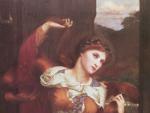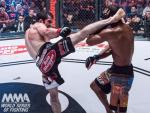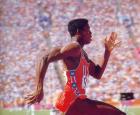What are the names of the Olympic mascots? Mascots of the Olympics in Rio de Janeiro. Reference. What is the logo for the Rio Olympics?
Over the long history of the Olympic Games, many creatures have become their mascots. We'll talk about the last ten.
Olympic Games mascot or mascot mascot- mascot) has become a mandatory attribute since 1972. According to the magazine GEO The mission of the Olympic mascot is to “reflect the spirit of the host country of the games, bring good luck to the athletes and intensify the festive atmosphere.” Most often, the national animal of the host country, or a fictional or mythological creature, becomes the mascot.
Rio de Janeiro 2016, Vinicius and Tom

Vinicius and Tom are the mascots of the 2016 Olympic and Paralympic Games in Rio. These are collective images of the animal and plant world of Brazil.
The Rio 2016 Olympic mascot is depicted as a smiling yellow animal. The symbol resembles a cat and symbolizes the rich fauna of Brazil. The Paralympic one is made in blue and green colors and represents flora. Their names were determined as a result of an online vote announced by the organizers of the Games immediately after the presentation.
The mascots were named in honor of the famous Brazilian musicians and composers Vinicius de Morais and Tom Jobim.
London 2012, Wenlock and Mandeville

The mascots of the thirtieth anniversary Olympic Games in London were two drops of steel from Bolton named Wenlock and Mandeville. They are named after the town of Much Wenlock, which hosted the first competitions like the Olympic Games, and the village of Stoke Mandeville, where the first Paralympic Games were held on British soil. Both mascots have one eye, wear bicycle helmets, and have the Games logos painted on them.
Beijing 2008, Fuwa

The mascots for this Olympics took several years to be selected. On the one hand, it was necessary to choose something traditional Chinese, and on the other, something unusual, so that when registering a trademark they would not be accused of plagiarism. The organizing committee received 662 sketches, among which were several tigers, a Tibetan antelope and even Hanuman, the mythological Monkey King. And exactly 1000 days before the opening of the Olympics, the chosen mascot was presented, which became the Fuwa Five.
In Chinese, Fuwa means Children of fortune. The five characters symbolize the five Olympic rings, each of them is painted in its own Olympic color and personifies the five natural elements: water, forest, fire, earth and sky. The first syllables of the mascot names, added together, make up the phrase Bei Jing Huan Ying Ni, which can be translated: Beijing welcomes you! These talismans are the most popular representatives of the country's fauna. The Bay Bay Blue Fish symbolized well-being, prosperity and patronized water sports. Her headdress repeats elements of Chinese jewelry from the Neolithic era. The Black Panda Jing-Jing, a symbol of China, personified harmony with nature, sincerity and happiness. He patronized weightlifting, martial arts, etc. His headdress contains floral patterns. The red Olympic flame of Huan Huan communicated with the Olympics and symbolized energy, passion, and the desire to win. He patronized team sports. His headdress is stylized after the rock paintings of the famous Mogao Caves. The yellow Tibetan antelope Ying Ying has become the embodiment of cheerfulness and health. She patronized athletics. Her headdress contains elements of national costumes. The Green Swallow Ni-Ni became a symbol of good luck, patronizing gymnastics. The headdress follows the design of traditional Beijing kites.
Athens 2004, Phoebus and Athena

The mascots of these Olympic Games were created according to ancient models found during excavations. They were made as exact copies of ancient Greek dolls dating back to the 7th century BC. According to legend, Phoebus and Athena are brother and sister. They were named after the Olympian gods Apollo (Phoebus, Phebos or Thebos), the radiant god of light, and Athena, the goddess of wisdom. IOC officials in Greece said the two figures are the perfect mascot for the upcoming Olympics as they successfully combine Greek history and modernity. However, the public was not very happy with the choice at first, but eventually came to terms with it.
Sydney 2000, Ollie, Sid and Millie

The mascots of the Sydney Games were three animals that live only in Australia: the Platypus, the Kookaburra and the Echidna. Together they symbolize Olympic friendship, and also personify the three elements: earth, water and sky. By the way, three is also a symbolic number, since this Olympics took place on the eve of the Millennium. Each of the talismans had its own name and original character. The platypus was named Sid (short for Sydney). A symbol of Australia's nature, it personified strength, energy and the desire to win. The Australian Laughing Kingfisher Ollie (short for the word Olympics), the embodiment of the Olympic spirit, was distinguished by her cheerful disposition, generosity and kindness. The echidna was named Milli (short for millenium in honor of the beginning of the third millennium). She combines optimism, hard work and a focus on the future. In addition, Millie was a symbol of information and technology, chief in terms of facts and figures.
Atlanta 1996, Izzy

The organizers of this Olympics thought for a very long time about the topic of the mascot and never came to a common conclusion. Therefore, the decision was made to generate it on a computer. The creature turned out to be very strange and unlike anything else. The original sketch was barefoot and had no mouth or nose. Designers have been bringing it back to normal for a long time. So Izzy got an expressive huge mouth, a tail with Olympic rings, white gloves and funny boots. Subsequently, it was decided to remove the ugly teeth so that the mascot would not look aggressive, and add sparkling stars to the wide-open eyes. With the name, everything also turned out to be very difficult. They also thought about him for a long time, and then they simply called him Izzy - an abbreviation for the English expression What is it? This mascot is considered the most failed project in the history of the Olympic Games.
Barcelona 1992, Kobe Puppy

On the eve of the Olympic Games in Spain, the political situation was not stable enough. Designer Javier Mariscal had a difficult task: to find an image that could unite the separatist provinces. This is how the mongrel Koby appeared, a stray puppy, a cartoon character of a popular children's television show. Kobe was already everyone's favorite, so he became the ideal mascot. And also the most stylish of all time, because he was wearing a dark blue suit and tie. Kobe is also considered one of the most successful mascots. And at the closing ceremony of the Olympics, Kobe, like the Moscow bear, was launched into the sky in a hot air balloon.
Seoul 1988, Little Tiger Hodori

Who else but the Amur tiger is destined to become the mascot of the Olympics in Korea? After all, he is the most important hero of all Korean legends. However, so that he would not seem intimidating and aggressive, it was decided to make the tiger small, kind and harmless. The name Hodori was chosen by all of Korea from 2,295 proposed options. The winning name can be translated from Korean as Tiger Boy. Hodori's main attribute is a small black cap placed over his ear. It was in these that once upon a time peasants performed dances during folk festivals. The tiger cub also initially had a girlfriend - the tigress Hosuni, but she turned out to be not at all popular and was soon forgotten about.
Los Angeles 1984, Sam the Eaglet

With Sam the eaglet, who has become the mascot of these American games, everything is very clear. The eagle is the national symbol of the United States, it's as simple as that. And he got his name thanks to another image - Uncle Sam, who had exactly the same stars and stripes top hat. It was invented for Eaglet by the company’s artists Walt Disney.
Moscow 1980, Misha the Bear

With the Moscow bear, everything is also clear right away. The brown bear is a symbol of Russia, so the choice was obvious. Although the Little Humpbacked Horse, Matryoshka and the Parsley doll were considered as talismans. But the newspaper Soviet sport appealed to the citizens of the USSR with a request for help in choosing a mascot, the editor received about 45 thousand letters, in which the bear was almost unanimously proposed. The author of just such a bear as we know was the famous illustrator Viktor Chizhikov. From more than a hundred images he came up with, he chose one, which took part in the final exhibition in Moscow. Sixty bears from different artists were included in the competitive selection. Everyone liked Misha. It was his sketch that was chosen and officially approved at the highest level. The Moscow mascot was the first of all to turn his face to the audience, looking at them and smiling openly. Misha had a wide belt with five Olympic colors and a ring-shaped buckle.
During the closing ceremony of the Games in Moscow, a large rubber Misha was launched into the sky on hot air balloons and thousands of spectators watched with tears in their eyes as the bear returned “to his fairytale forest.” After the Olympics, this bear was exhibited in one of the VDNH pavilions. There is a legend that in the fall of 1980, a West German company tried to buy the rubber bear for a large sum, but the USSR government refused to sell the national symbol, it fell into disrepair and disappeared somewhere in the basements. Yes, there is also a version that this bear’s name was not Misha, but Mikhail Potapych Toptygin.
The logo for the XXXI Summer Olympic Games 2016 in Rio de Janeiro was designed by the Brazilian design studio Tatil Design and was first presented to the general public on December 31, 2010. The symbol is based on a stylized Rio: mountains, sun and sea in the form of winding lines, reminiscent of silhouettes of dancing people holding hands. The motto of the main sporting competition is “We are all Brazil.”
The mascots of the games were Vinicius and Tom, who were chosen in honor of the famous Brazilian musicians and composers Vinicius de Morais and Tom Jobim. Talismans are collective images of the flora and fauna of Brazil. Vinicius is depicted as a smiling yellow animal and resembles a cat, symbolizing the rich fauna of Brazil. The volume is made in blue and green colors and represents flora.

“The Gods of Olympus are going to Rio de Janeiro” is the name of the official anthem of the 2016 Olympics. The anthem sounds in samba rhythm. Brazilian stars perform the song.
By the way, the Leo Burnett agency made a video for Samsung called "Anthem" in which people from different countries sing a line from their national anthem, but it feels like everyone is singing the same song. The video has already received 28 million views.
In the Nike video, newborns played the role of future sports stars. The video has received almost 24 million views. According to the plot of the video, a speaker comes to the kids and gives a motivational speech about responsibility for their future. Among the signs on children's cribs are the names of Neymar, Serena Williams and Mohamed Farah.
In the spring, Samsung released a short documentary film, “Chance for Success,” which tells the story of the courage, hope and perseverance of four candidates for participation in the Olympic Games. The film about an athlete from South Sudan, whose team will compete at the Olympics for the first time this year, was a continuation of the story. The video about her has already collected just over 22 million views.
Always, continuing its #LikeAGirl campaign, inspires teenage girls around the world to stay involved in sports. And this video has already collected almost 22 million views.
100 days before the opening ceremony of the 2016 Olympic Games in Rio de Janeiro, Procter & Gamble, as part of its “Thank You, Mom!” presented a new video “The Power of Mom.” The number of views for this video is approaching 20 million.
And the Minute Maid company presented in its video, which collected almost 6 million views, the sports story of Franklin Missy, who put her parents in the spotlight.
The official broadcaster of the 2016 Paralympic Games, Channel 4, created a video about people with disabilities who make up an entire orchestra. The video has already received more than 3 million views.
Visa showed a summer trip with the brand's team athletes. The video received 2.5 million views.
It is a yellow-colored animal, a collective image of the Brazilian fauna, simultaneously resembling a monkey and a parrot. The talisman was named after the outstanding Brazilian musician and poet Vinicius de Morais.
The mascot of the Paralympic Games was also named - a blue-green plant that combines the features of a flower and a tree. He was named Tom - in honor of the Brazilian composer Tom Jobim, who collaborated with di Morais for many years.
History of Olympic mascots
Recently, a presentation of the mascots of the 2016 Summer Olympic and Paralympic Games took place in Rio de Janeiro. One of the bright yellow talismans resembles a cat. According to the designers, it should symbolize the fauna of Brazil. The second is green, looks like a palm tree and is associated with the flora of Brazilian forests. Names for the characters have not yet been invented. They will be determined later by open voting on the official website of the Olympic Games in Rio de Janeiro.
Mascots of the 2016 Games
The history of Olympic mascots, which are sometimes also called “mascots” (from the English mascot - “mascot”) is not very rich, but fascinating. The first unofficial mascot appeared in 1968 at the Games in Grenoble. It was a skier with Olympic rings on his forehead named Schuss. In October of the same year, the Red Jaguar mascot, based on a sculpture found during excavations at Chichen Itza, the ancient Mayan capital, was introduced at the Summer Olympics in Mexico City.
Both the Schuss Skier and the Red Jaguar were rather unattractive to look at (we didn't dare include pictures of them here) and were not particularly successful. However, the organizers of the Games liked the idea itself, so four years later, in the summer of 1972, at the session of the International Olympic Committee (IOC), held as part of the XX Olympic Games in Munich, the first mascot of the Summer Games was officially registered - the multi-colored dachshund Waldi. At the same time, it was decided that the mascot could be some kind of fairy-tale creature, reflecting the cultural characteristics of the people - the host of the Olympics, an animal and even a person.
So, the mascots of the last ten Olympics:
Waldi the Dachshund (Munich, 1972)

Waldi the Dachshund
Dachshunds have the qualities of a true athlete: stamina, perseverance and agility. The word “dachshund” in German is masculine, and Waldi is a common noun for dachshunds in Germany, just as Murka is a common noun for cats in Russia. Waldi the dachshund was the only pet in the history of Olympic mascots and the first mascot to be given its own name.
Beaver Amick (Montreal 1976)

Beaver Amik
In the language of North American Indians, “amik” is a beaver. Beavers are also not unfamiliar with the qualities of a true athlete - patience and hard work. In addition, the beaver is a symbol of Canada, and its image can be found on coins and even some state seals.
Misha the Bear (Moscow 1980)

Little Bear Misha
“Our affectionate Mishka” also has a full official name - Mikhail Potapych Toptygin. Toptygin was approved at the highest level - in the CPSU Central Committee. As the author of the Olympic Bear, children's artist Viktor Chizhikov, recalls, they called him and said: “Congratulations! Your bear passed the Central Committee!” According to legend, after the closing of the 1980 Olympics, the Soviet government received an offer from a German company to buy Misha for 100 thousand Deutschmarks. Of course, the company was refused.
Sam the Eaglet (Los Angeles 1984)

Sam the Eaglet
The top hat on the eaglet's head was supposed to add aggressiveness to this talisman - most people at that time associated the United States with the image of “Uncle Sam.” Actually, that’s why this mascot was named Sam. Meanwhile, the organizers constantly had to refute accusations of militarism and explain that the eagle is the national symbol of America.
Little Tiger Hodori (Seoul 1988)

Tiger Cub Hodori
To avoid unnecessary associations, let us immediately explain the etymology of the word “Khodori”. “Ho” means “tiger” in Korean, and “dori” is a diminutive for “boy.” It was not by chance that the tiger was chosen for the Seoul Olympics - this animal appears in almost all legends in Korean folklore. Let us add that Hodori is an Amur tiger, and it took a very long time to choose his name - 2,295 names were proposed from all over the world.
Kobe the Puppy (Barcelona 1992)

Kobe puppy
Spain, on the eve of the 1992 Games, was also torn apart by separatism, so the symbol was supposed to unite the provinces of the country: Castile, Catalonia, Andalusia and Galicia. The yard puppy Kobi, who does not boast of his origin and breed, volunteered to play the role of unifier. The Spaniards initially did not like the dog Kobe, calling the work of animator Javier Mariscal a failure. However, by the end of the Games, the demand for the plush toy exceeded supply many times over, and Kobe the puppy was even made the hero of the animated series.
Izzy (Atlanta 1996)

For a long time, the organizers of the Atlanta Olympics could not come up with a name for this mascot. The end result was Izzy. Short for English “What is it?” - "What is this?" Izzy became the first mascot in history not created by a person, but by a computer. The machine was asked to create an average image of an athlete, a cartoon character and a typical American. The given “result” had neither a mouth nor a nose, and even turned out to be barefoot. The designers realized that they couldn’t do it without Photoshop. Subsequently, the artists squeezed a star into each eye of the poor fellow.
Ollie, Sid and Millie (Sydney 2000)

Ollie, Sid and Millie
Sid is a platypus, Ollie is an Australian kookaburra parrot, and Millie is an echidna. Their names were not chosen by chance. Sid is short for Sydney, Ollie is short for Olympics, and Millie marks the start of the new millennium (from millennium). These three symbolize friendship and personify the three elements - earth, water and sky. In addition, each of the talismans has its own character: Sid is strength, energy, and the desire to win. Cheerful Ollie - generosity and kindness. And Millie personifies hard work, optimism and a focus on the future.
Phoebus and Athena (Athens 2004)

Phoebus and Athena
The Apollo and Athena dolls were modeled after toys that existed in Ancient Greece. Their names go back to two gods who participated in the Olympic Games: Phoebus, god of light and music, known as Apollo; and Athena, goddess of wisdom. Phoebus and Athena cemented the connection between the ancient and modern Olympic Games.
Wenlock and Mandeville
Wenlock and Mandeville are two one-eyed alien-like creatures. Wenlock got its name in honor of the town of Much Wenlock, competitions in which in the mid-19th century inspired Pierre de Coubertin to revive the Olympics in 1896. Mandeville was named after Stoke Mandeville Hospital, where the first games for disabled athletes were held in 1948.
Snow Leopard, White Bear and Bunny (Sochi 2014)

Logo XXXI Summer Olympic Games 2016 in Rio de Janeiro designed by the Brazilian design studio Tatíl Design and first presented to the general public on December 31, 2010.
The symbol is based on a stylized Rio - mountains, sun and sea in the form of winding lines reminiscent of silhouettes of people holding hands and dancing.
The logo is made in the colors of the national flag of Brazil - blue, yellow and green - and is intended to symbolize interaction and energy, harmony in diversity, the exuberance of nature and the Olympic spirit.

Vinicius and Tom are the mascots of the 2016 Olympic and Paralympic Games in Rio de Janeiro
The official presentation of the mascots of the 2016 Summer Olympic and Paralympic Games took place on November 24, 2014. The organizers presented collective images of the flora and fauna of Brazil.
The Rio 2016 Olympic mascot is depicted as a smiling yellow animal. The symbol somewhat resembles a cat and symbolizes the rich fauna of Brazil. The Paralympic one is made in blue and green colors and represents flora.
The new symbols of Rio 2016 were greeted at the presentation ceremony by their predecessor mascots - Misha (Moscow 1980), Athena (Athens 2004), Fuwa (Beijing 2008) and Wenlock with Mandeville (London 2012).
On December 15, 2014, the mascots of the 2016 Olympics and Paralympics in Rio de Janeiro acquired official names, which were determined as a result of a three-week online vote announced by the organizers of the Games immediately after the presentation. Voters were offered several pairs of names to choose from, including Oba and Eba, Tiba-Tuki and Eskindim, Vinicius and Tom. The last two are in honor of the famous Brazilian musicians and composers Vinicius de Morais and Tom Jobim.
- Vinicius and Tom - 44%
- Both and Eba - 38%
- Tiba-Tuki and Eskidim - 18%

The official pictograms of the sports included in the program of the XXXI Summer Olympic Games 2016 in Rio de Janeiro were presented in November 2013.
A total of 64 pictograms were made - 41 for Olympic and 23 for Paralympic sports.
Work on them began in July 2012 and lasted 16 months, five of which were spent on approval from 42 International Sports Federations.
A team of 28 artists and graphic designers worked on the creation of the Olympic pictograms. “We tried to combine the dynamism and tension of the competition with the fun, relaxed atmosphere of Rio de Janeiro in a single visual image,” Lula Beth, the head of the creative team, told reporters.
Some sports are represented by several pictograms. For equestrian sports, jumping, dressage and eventing are separately detailed. Cycling is represented by four icons - track racing, road racing, mountain biking and BMX. Such scrupulousness was demonstrated for the first time in the history of the Olympics.
Rio 2016 Olympic and Paralympic pictograms will be used on tickets, various products, and as indicator signs.
Photo: Rio 2016 mascots got their names
The mascots for the 2016 Summer Olympics and Paralympics in Rio de Janeiro were named Vinicius and Tom. These names were chosen by Brazilians through online voting.
The mascots are named after Brazilian musicians Vinicius de Morais and Tom (Antonio) Jobim based on a public vote. Vinicius and Tom received 44% of the 323,327 votes, Oba and Eba 38%, Tiba Tuke and Eskidim 18%.

The Rio 2016 mascots were unveiled at the end of November. They became collective images of the Brazilian flora and fauna of Brazil.
The image of the fauna is presented in the form of a smiling yellow animal that somewhat resembles a cat. But the image of the Brazilian flora resembles a blue-green plant with leaves on its head.

It is expected that in the near future the symbols of the Brazilian Olympics will become the heroes of a show that will be launched on Brazilian television.
The Olympic Games will be held in Rio de Janeiro from August 5 to 21, 2016. Let us remember that in 2014 Brazil hosted the FIFA World Cup.








 What is compression clothing
What is compression clothing Cyclones and anticyclones Flettner's wind ship
Cyclones and anticyclones Flettner's wind ship Fastest man in the world
Fastest man in the world Descenders for industrial mountaineering Unicender - created by the Anglo-American company Morgan&Thompson
Descenders for industrial mountaineering Unicender - created by the Anglo-American company Morgan&Thompson